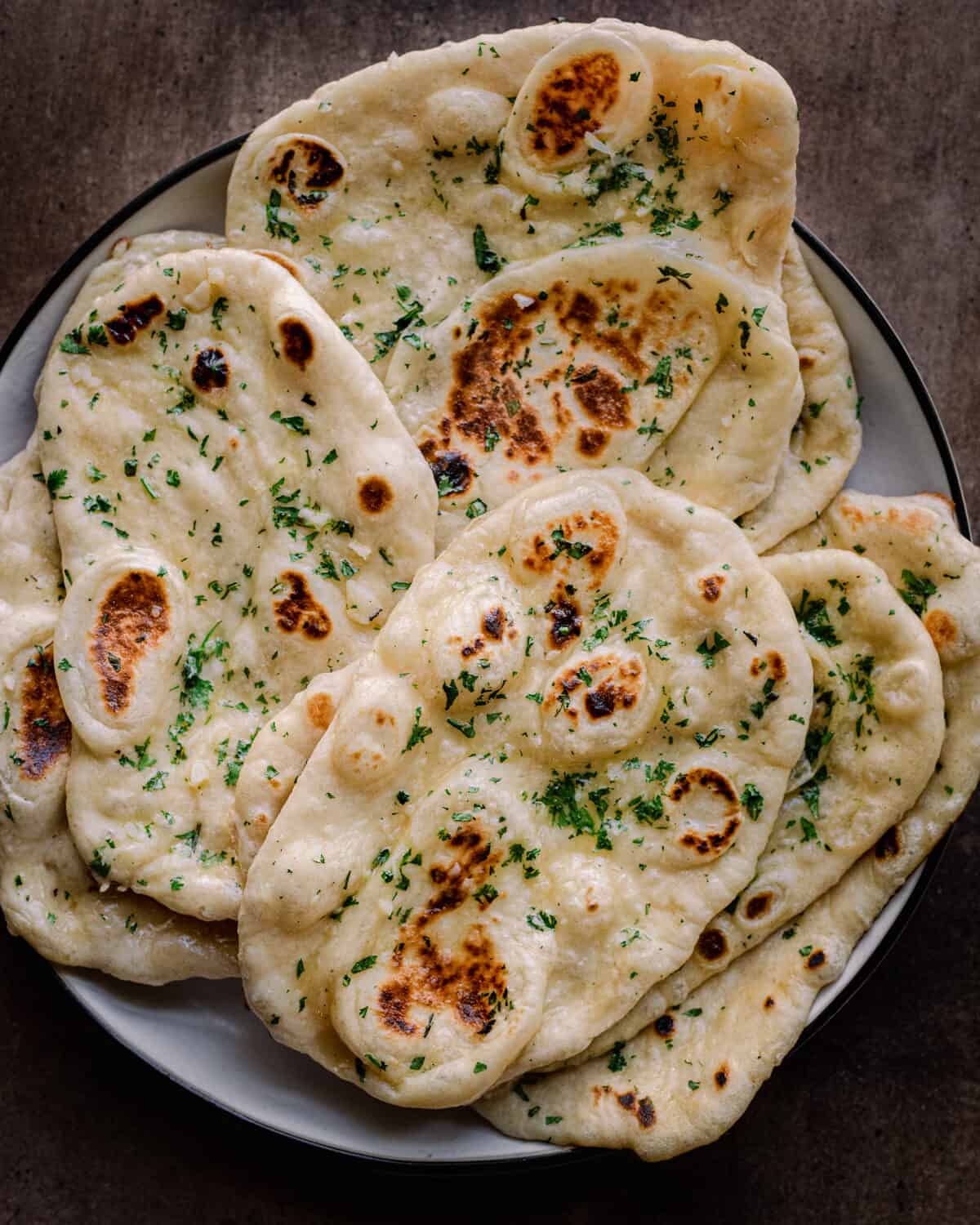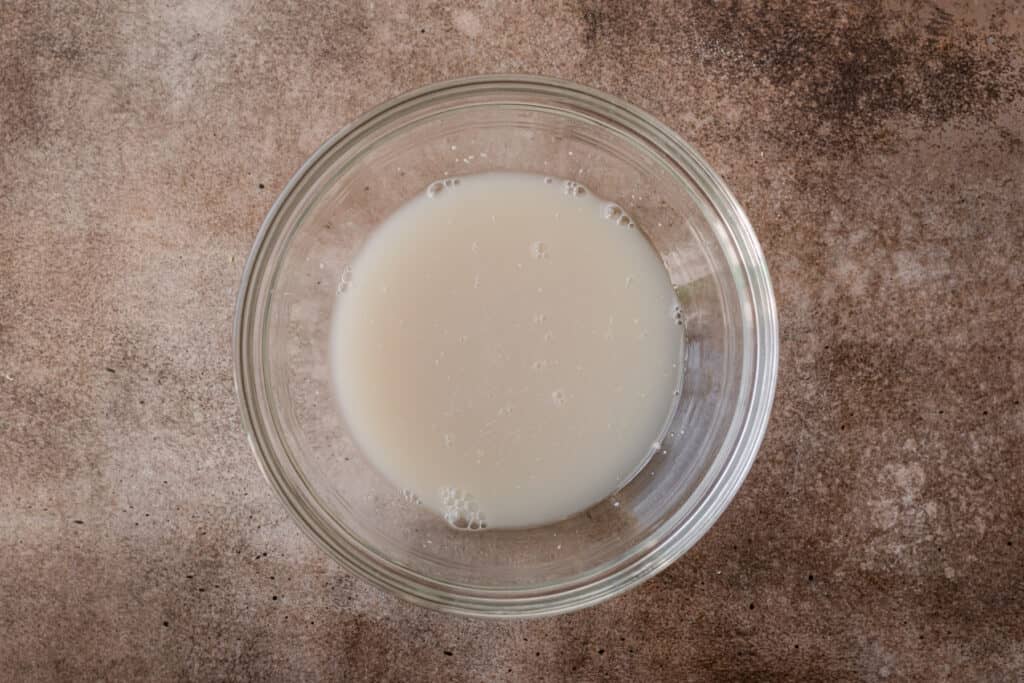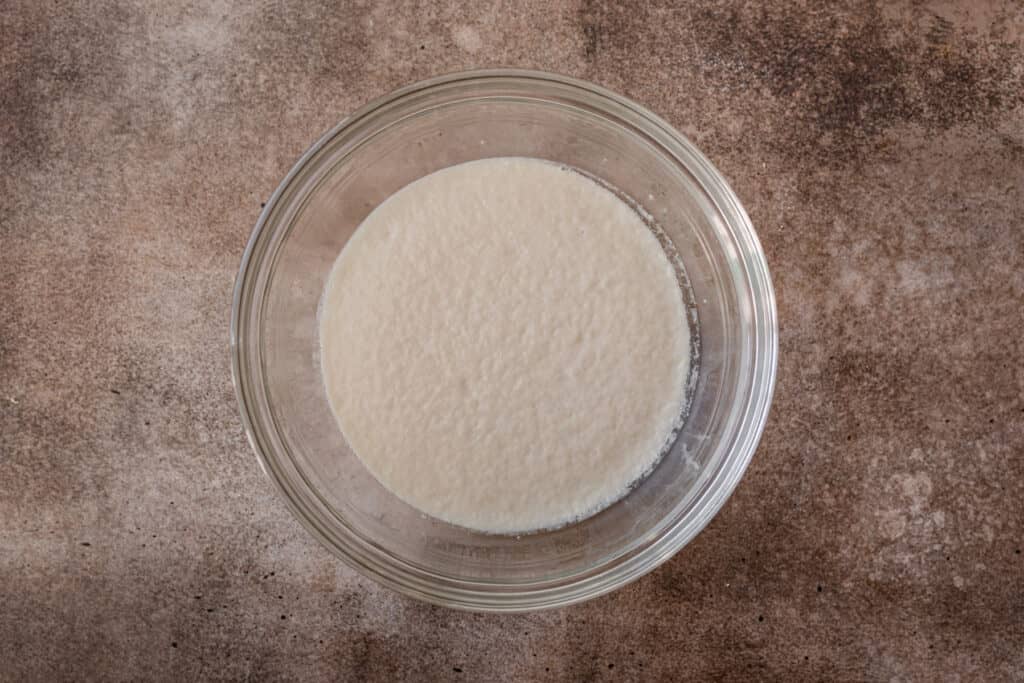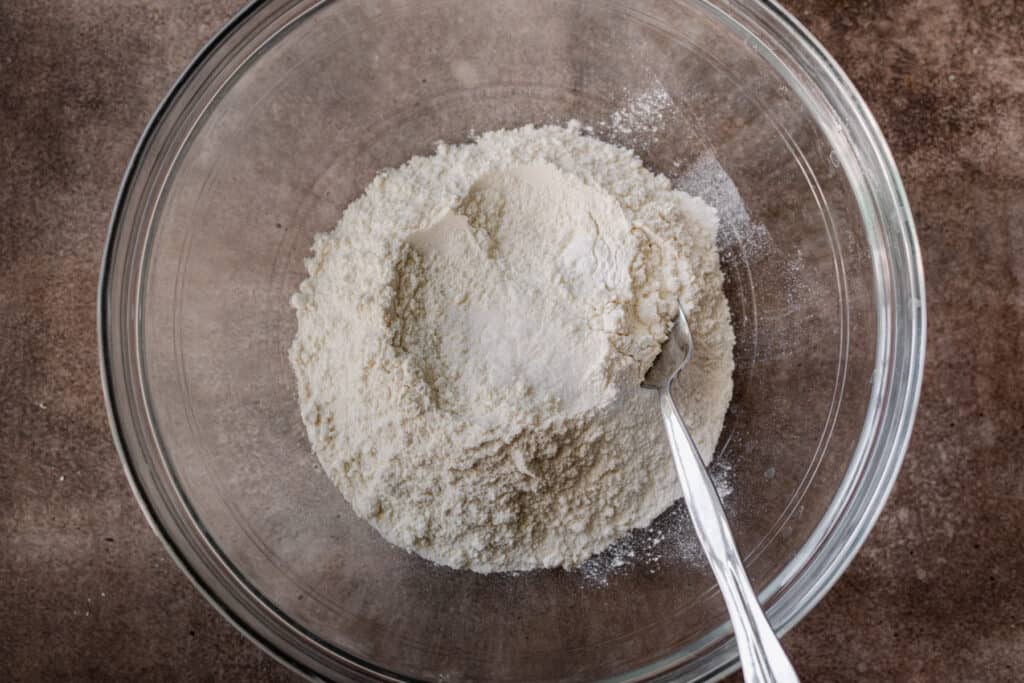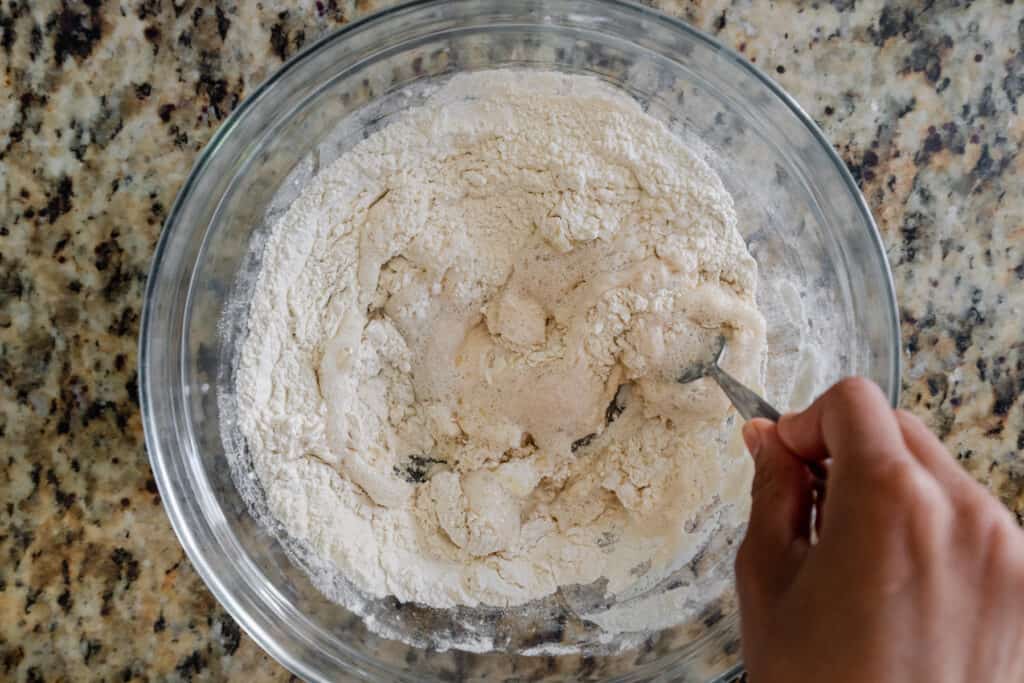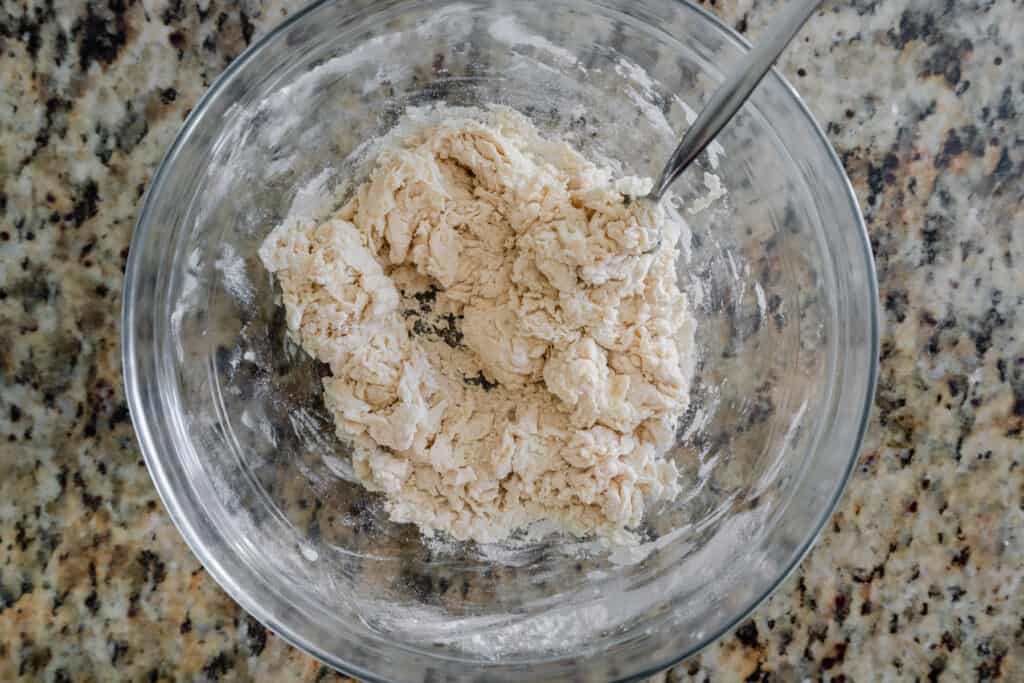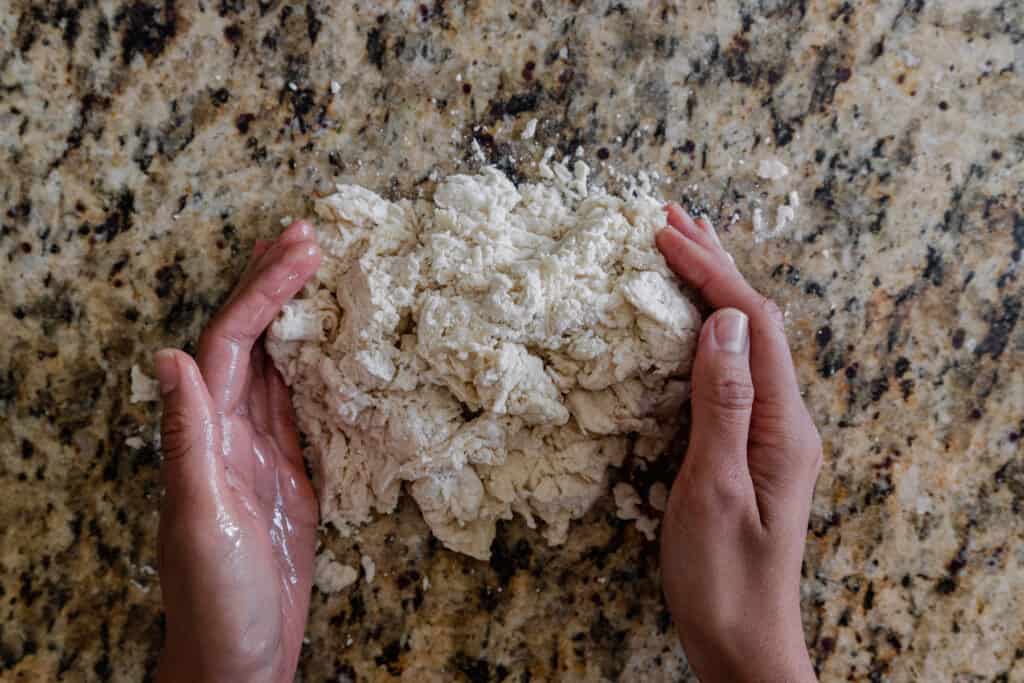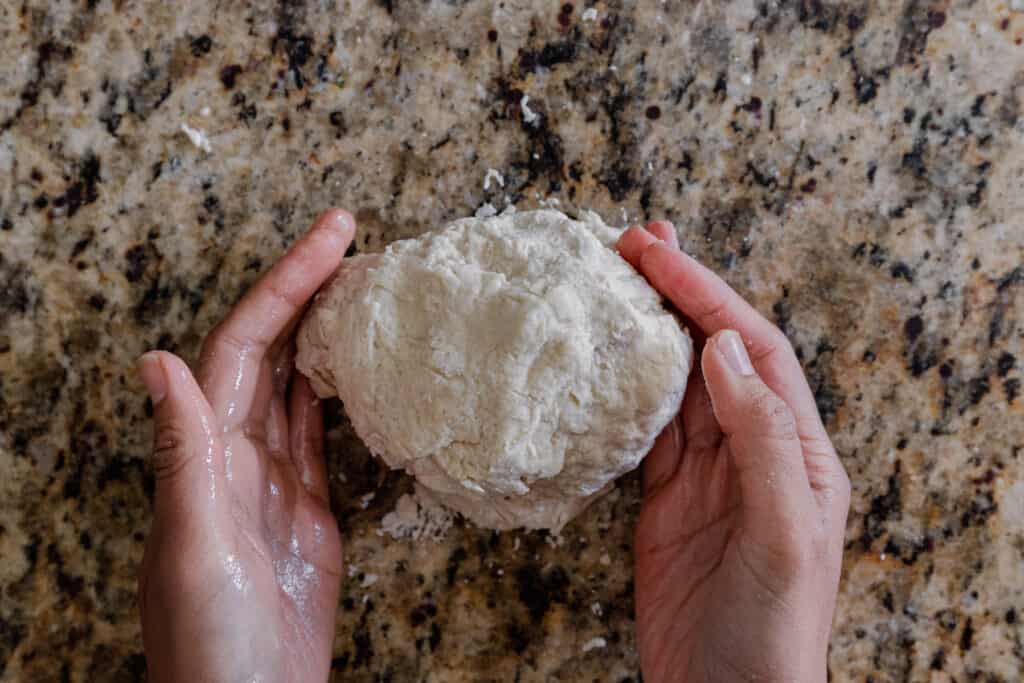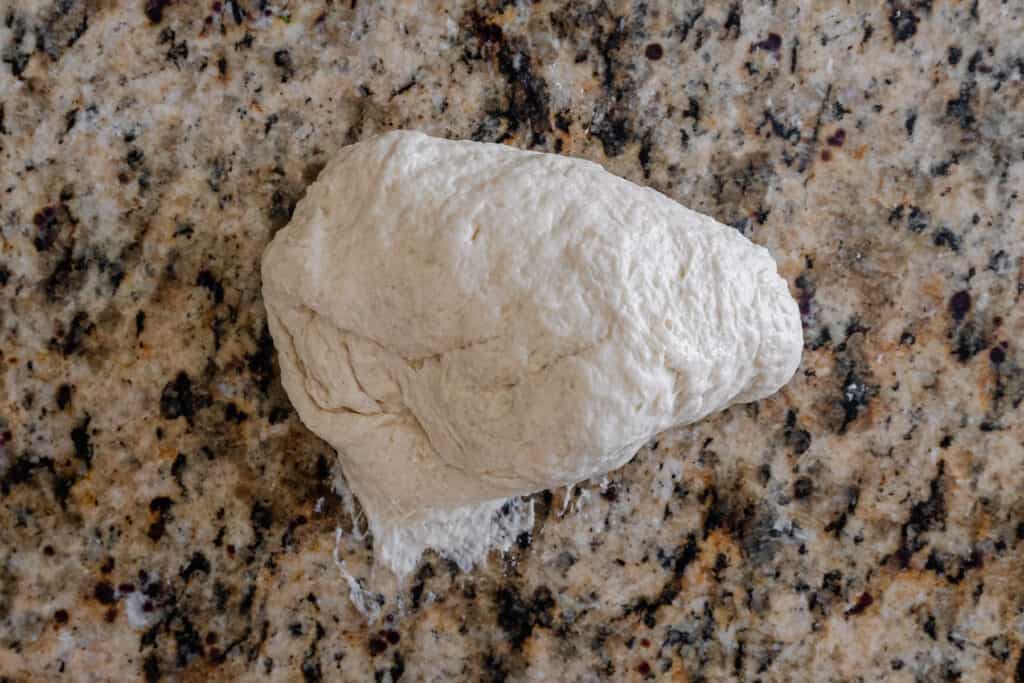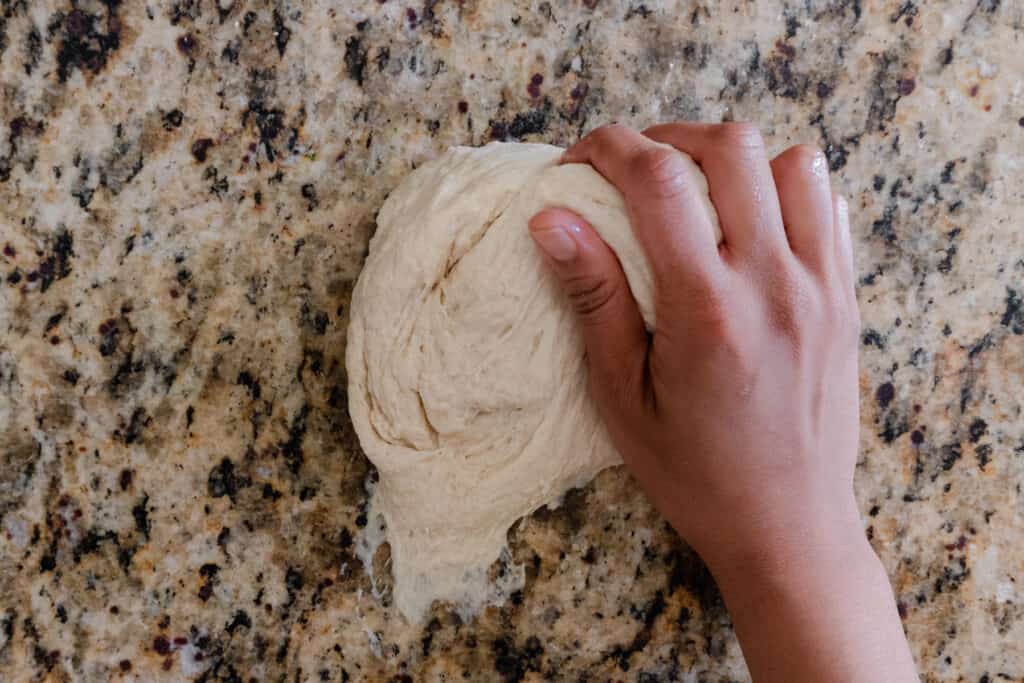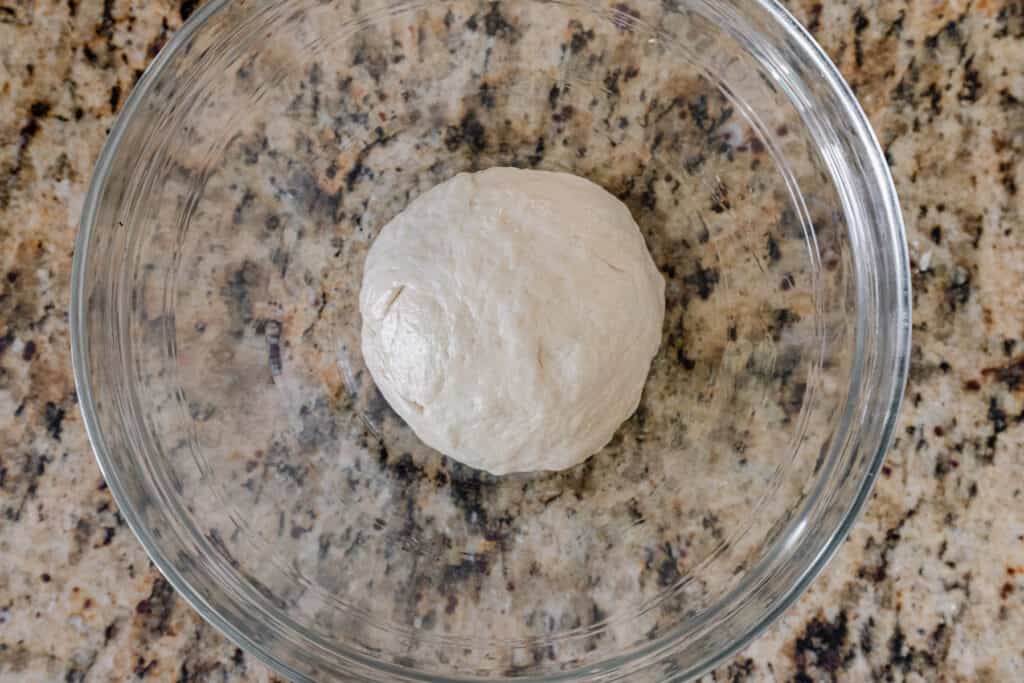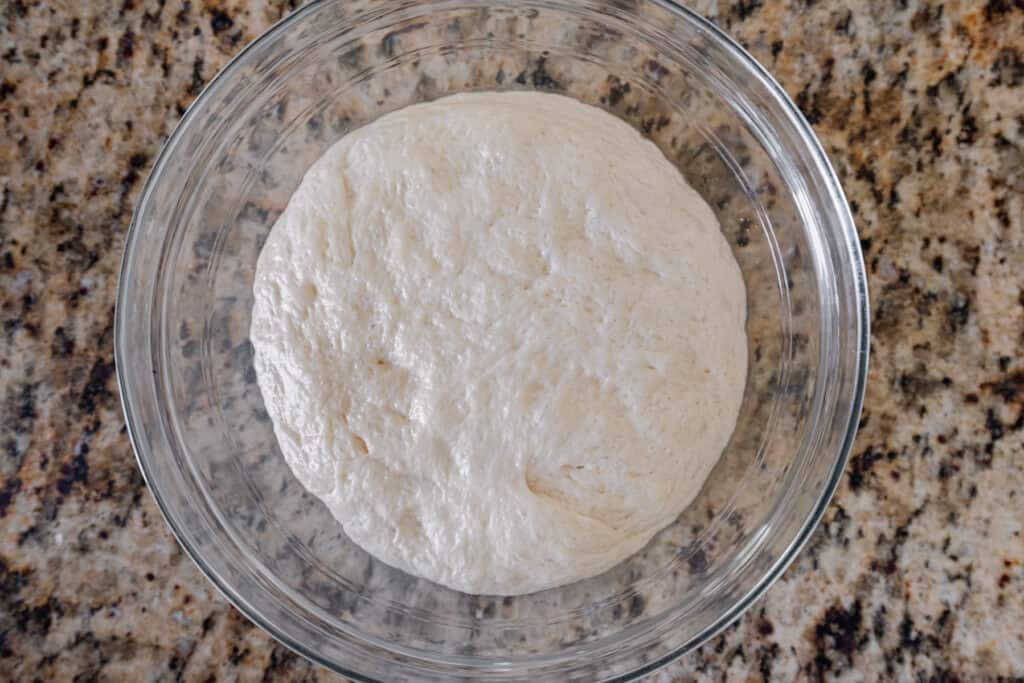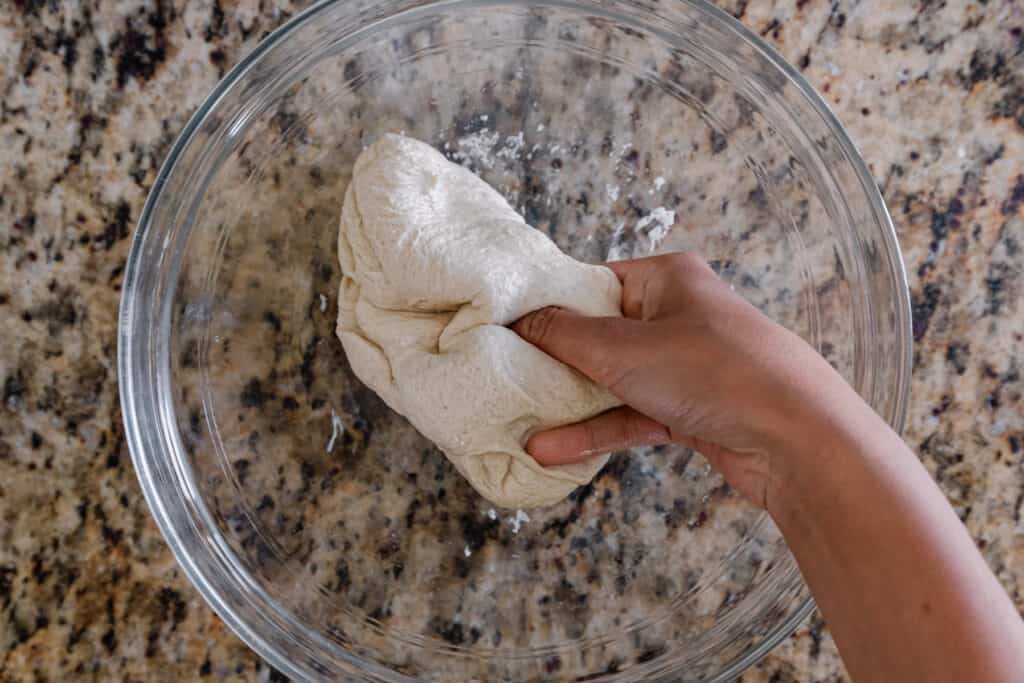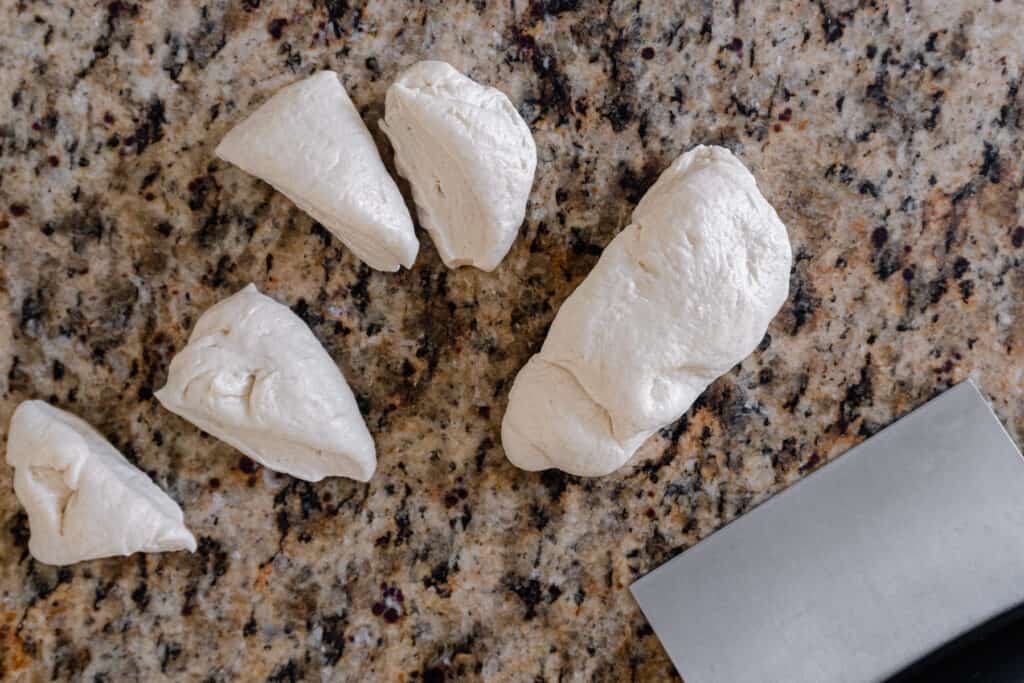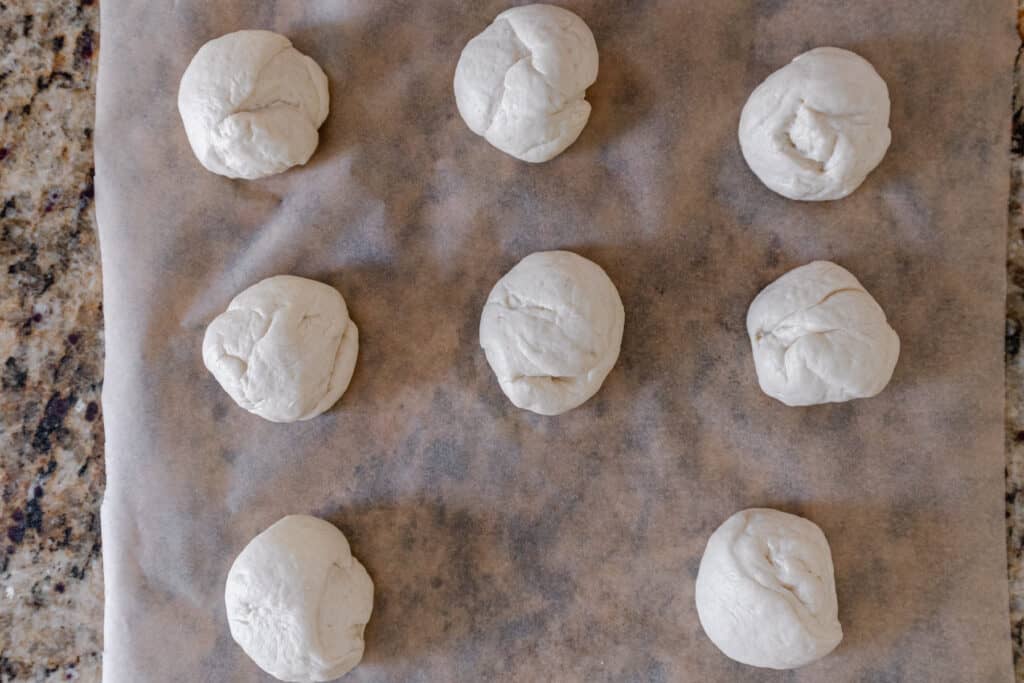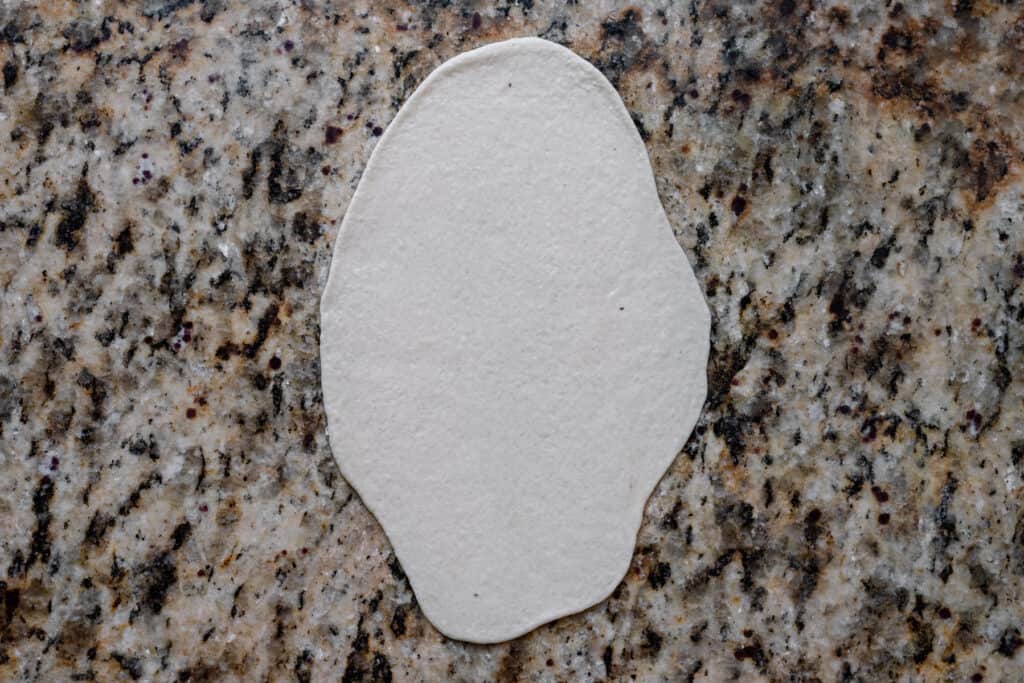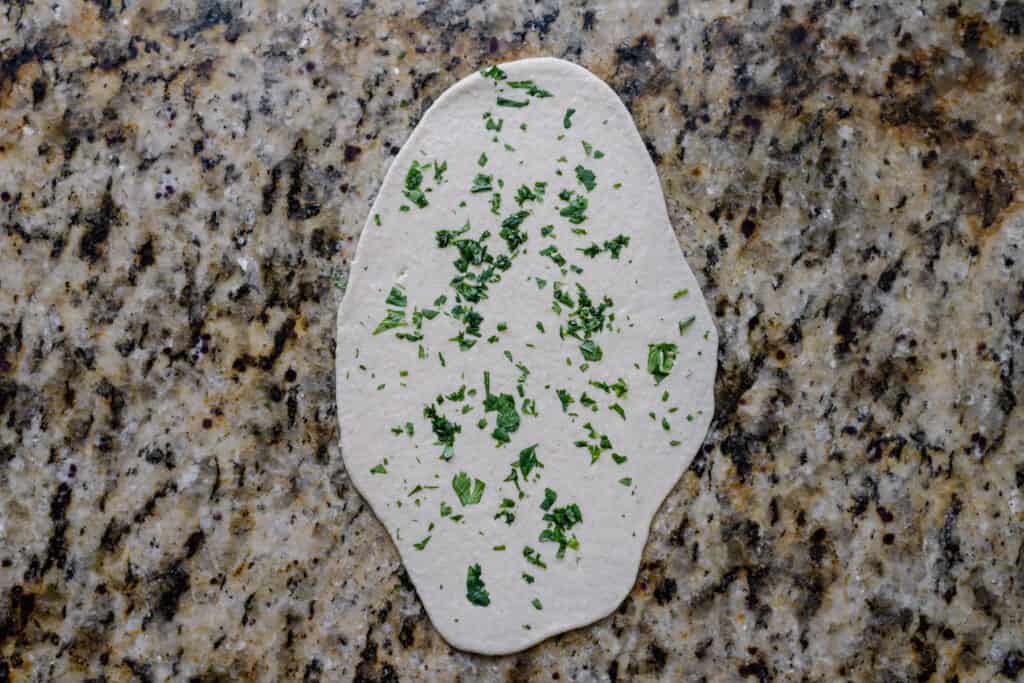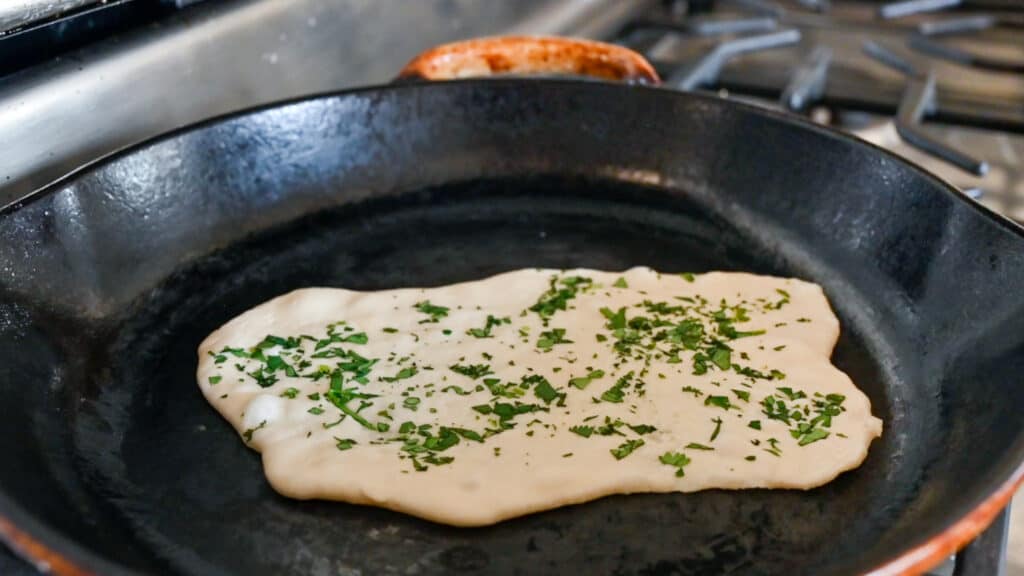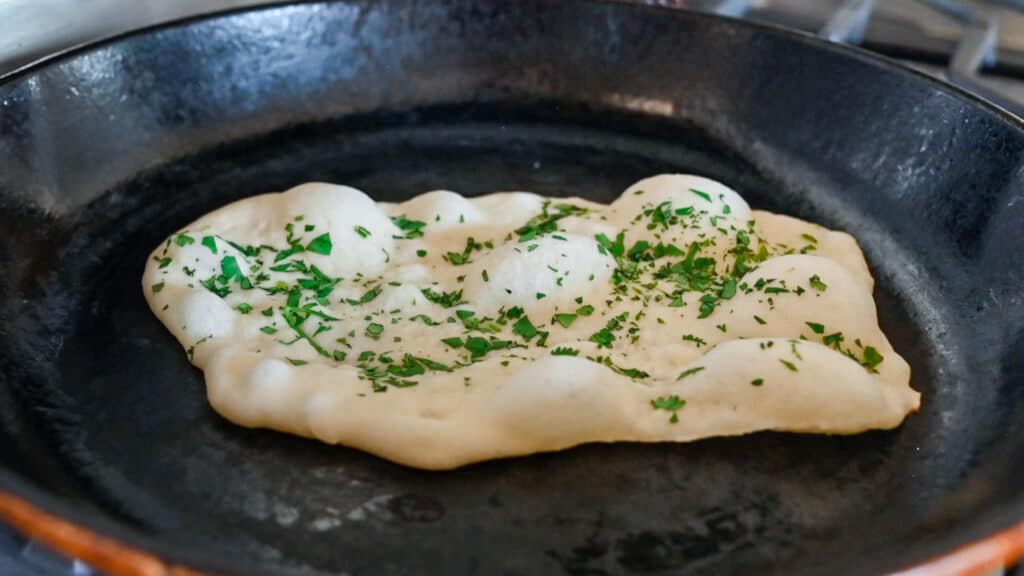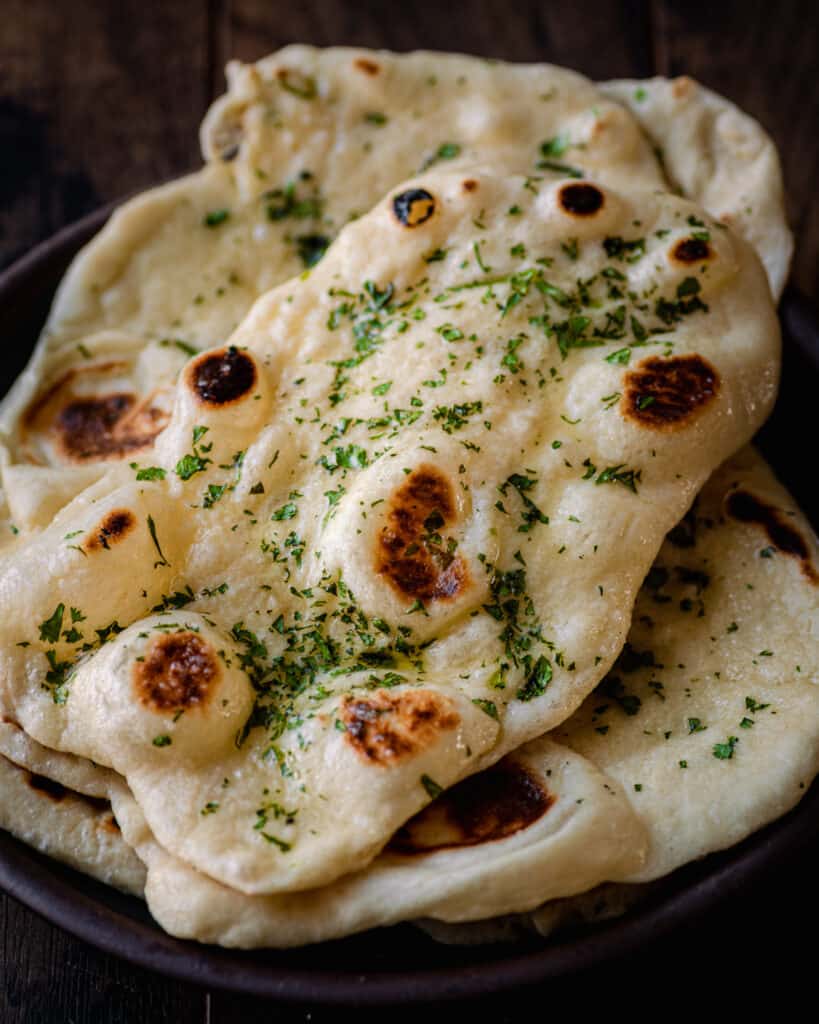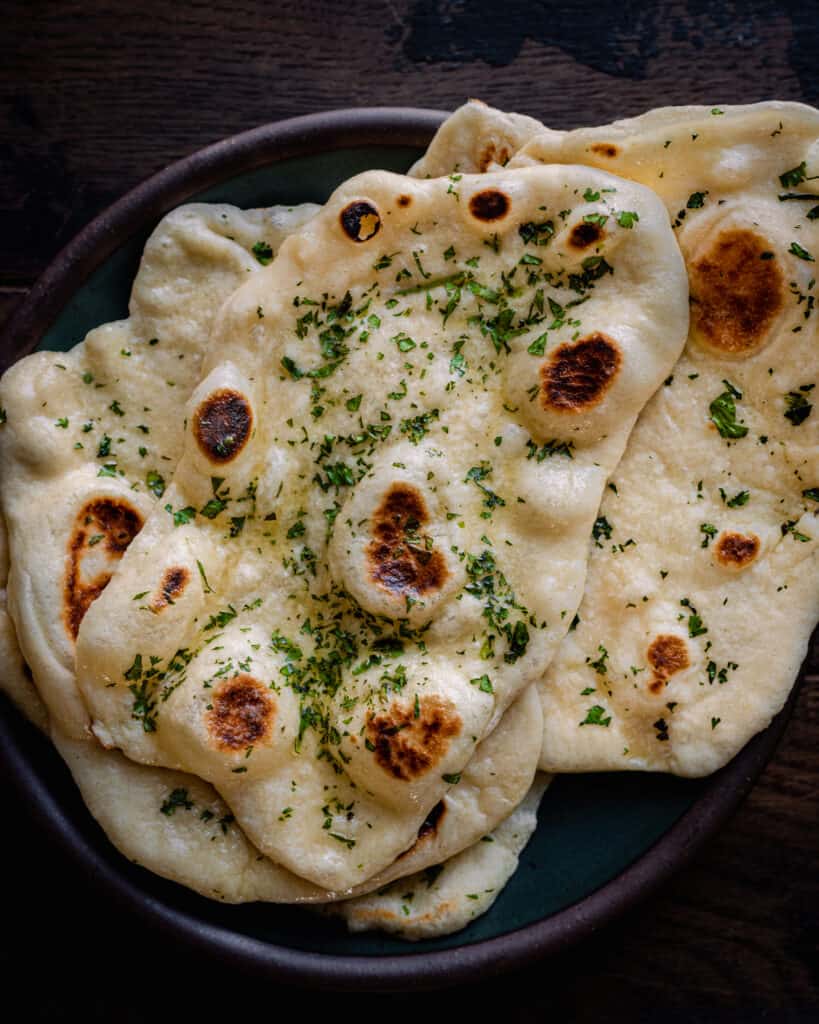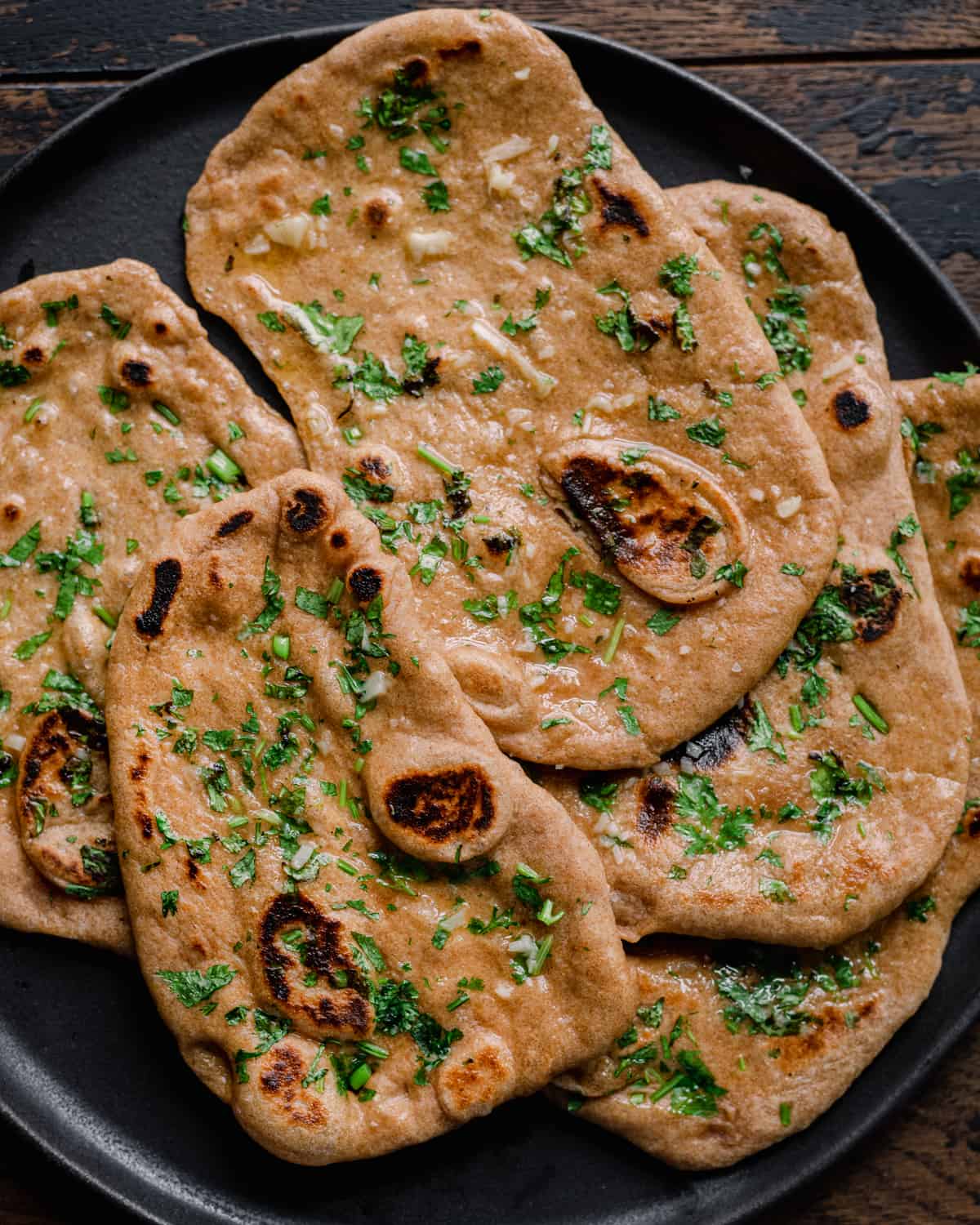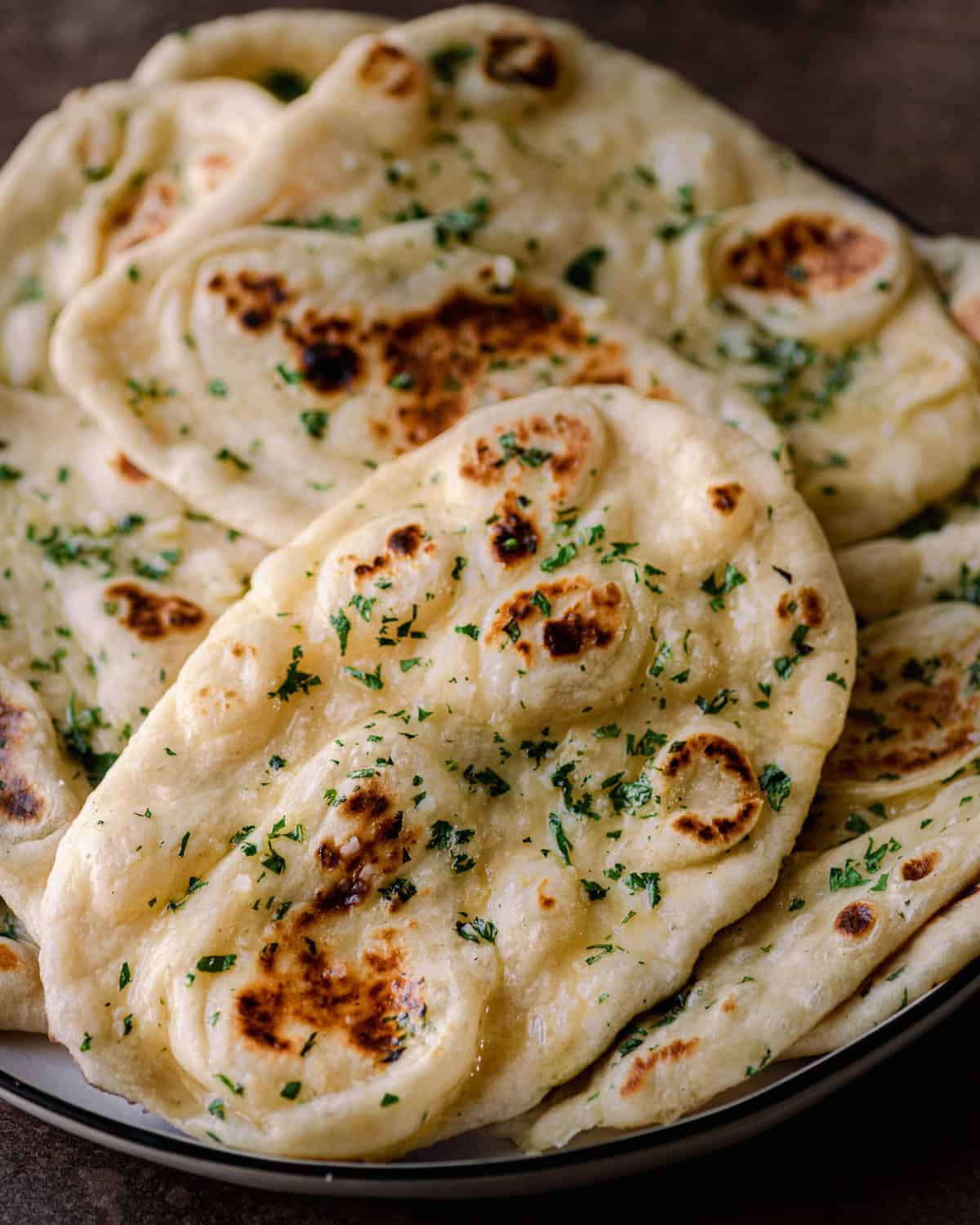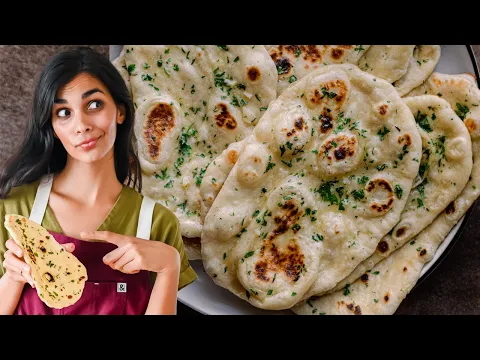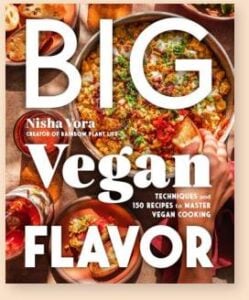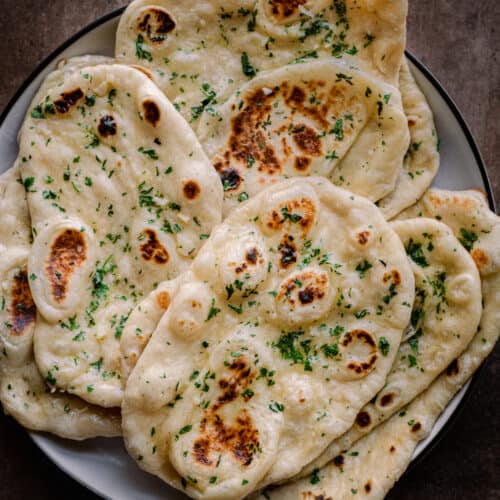Unfortunately, most naan you’ll get at Indian restaurants is not vegan, as the dough often contains yogurt (or milk) and it’s brushed with melted butter. While there are a handful of store-bought vegan naan options, they are pretty lackluster and taste more like store-bought pita bread. Not a bad option if you need something, but incomparable to freshly made naan.
What is naan?
Naan is an Indian leavened flatbread traditionally baked in a tandoor oven (a very hot clay oven). If you’ve been to an Indian restaurant, you’ve probably had the pleasure of eating naan. While there are dozens of amazing Indian breads, naan is probably the most well-known in the West. You’ll also find naan (and variations thereof) in the cuisines of Western and Southern Asia, Myanmar, Indonesia, and parts of the Caribbean.
Texturewise, naan is somewhat similar to Middle Eastern pita, but usually softer and thicker yet also more airy at the same time, thanks to its uneven gas pockets.
Most naan recipes start with all-purpose flour, salt, active dry yeast, and water. Yogurt or milk is often (though not always) added, and occasionally egg is added to the dough. The dough is kneaded by hand and then set aside to rise. In restaurants, the naan is usually baked in a tandoor oven, but in homes, it’s typically cooked in a very hot pan on the stove. The traditional Indian pan used is an iron tawa, but well-seasoned cast iron skillets also work well. Naan is almost always brushed with butter or ghee before serving.
How to make vegan naan
Bloom the yeast. Stir the sugar in the lukewarm water until dissolved. Add in the active dry yeast and whisk to dissolve, about 15 seconds. Set aside for 15 minutes until the yeast becomes foamy and a bit frothy (the photo on right is after 15 minutes).
Restaurant-Quality. This naan recipe is as good as Indian restaurant naan or even better (I think it’s even better, especially when served warm). Even without using yogurt or a tandoor oven, this naan is incredible and melts in your mouth. And of course, it’s the perfect vehicle for scooping up your favorite Indian curries and dals.
Even just within coconut yogurts, there was too much variation across brands that it didn’t make sense to include vegan yogurt as an ingredient. A few of the yogurts worked well, others made the dough too sticky, others made the dough hard to roll. And the amount of yogurt was very finicky, a result of how the various active cultures interact with the yeast (2 tablespoons of yogurt wasn’t enough to make a difference, but 3 tablespoons was slightly too much).
And when using a plant-based milk, the doughs seem to get either sticky or tough (soy milk basically turned the dough into a semi-hard rock).
So, really, all you need to make great naan is: flour, salt, yeast, water, and oil. The only “specialty” ingredient you need is a few tablespoons of vegan butter for brushing on at the end (please don’t skip that part, and make it even better by grating fresh garlic into the butter for garlic naan). Okay two more things: some cilantro to roll into the dough for extra flavor and flaky sea salt for sprinkling on that end. That’s it!
Tip: To test if yeast is fresh: mix together 1 teaspoon sugar + 1/2 cup lukewarm water (100-110ºF) + 2 teaspoons active dry yeast in a medium bowl. Stir, and set aside. After a few minutes, yeast should start to expand, and within 10 minutes, the mixture should be foamy and bubbly. If not, it’s expired and you’ll need new yeast.
While the yeast is resting, stir together the dry ingredients: all-purpose flour, sea salt, and baking powder.
Once the yeast mixture has activated, pour it into the flour mix and add 1 tablespoon of neutral-flavored oil.
Start mixing the ingredients with a fork. Mix until the dough is shaggy and you can’t stir it anymore with the fork.
Pour a bit of neutral-flavored oil on your hands to grease them. Transfer all of the dough to a clean work space. Start kneading the dough with your hands. You will need to oil your hands several times during the kneading process.
As you knead, you’ll notice the dough becomes quite sticky. It will stick to the counter and to your hands. Don’t worry and just keep kneading the dough for a total of 4 to 6 minutes.
Knead the dough until it is no longer sticky and is instead soft, pliable, elastic, and fairly smooth. It should feel well hydrated but no longer sticky. Pour a bit of oil in a large bowl, add the dough ball, and coat the dough on all sides in the oil.
Cover the dough with a clean dish towel and set aside in a warm place for at least 90 minutes, or up to 4 hours. I turn the light on in my oven and rest it in the oven.
After rising, the should have risen and at least doubled in size. Lightly punch down on the dough to release the air. Then use your hands to briefly knead the dough until it’s back into the shape of a ball.
Use a bench scraper to cut the dough into 8 pieces. If you want smaller naans, you can do 10 pieces. Use your hands to roll each dough piece into a round.
Proof the dough. Transfer to a sheet of parchment paper and cover with a clean dish towel. Allow to rest for 10 minutes (this is the dough’s second rise).
Use a rolling pin to roll the dough into a thin oval shape about 8″ long and 5″ wide at its widest, rolling outward and off (instead of rolling back and forth on the same spot).
Sprinkle the naan with a couple sprinkles of chopped cilantro. Dampen your fingers in some water and carefully pick up the naan. Flip it onto its backside and pat a bit of water all over the backside.
Use damp hands to carefully transfer the naan to the hot cast iron skillet, watered side down. Cook for 45 to 60 seconds, until bubbles puff up all over the naan.
Flip the naan and cover the pan to steam the naan for 30 to 40 seconds, then take off the heat and transfer to a plate.
Brush the hot naan with melted vegan garlic butter and sprinkle with a pinch of flaky sea salt. Serve warm!
Tips for making vegan naan
Making naan can be tricky, especially your first time, because yeast is a fickle ingredient. The way yeast interacts with other ingredients depends on several factors, including its food source, the temperature of the water, and the temperature of the dough’s resting environment. Changes in any of these result in changes in the dough (e.g., using water at 99ºF instead of 105ºF makes a noticeable difference).
Takeway: I strongly encourage you to read through all of these tips before making this recipe.
Use lukewarm water to activate the yeast. Cold water won’t activate the yeast (and it will make the dough too sticky). Hot water will kill the yeast.
Tip: To ensure success each time you make this recipe, measure everything using a digital scale down to the gram.
Note: The water should be between 100-110ºF (37.8-43.3ºC) in order to activate the yeast. I recommend having a cooking thermometer (affiliate link) in your kitchen. I usually microwave room temperature water for 20 to 25 seconds and that usually gets me in the range.
Try to avoid adding more water or flour while kneading. When you start kneading the dough, it will look fairly dry. Just start kneading, and very soon, the dough will become very hydrated and sticky.
If you measure precisely (e.g., using a measuring scale in grams/milliliters), you should not have to add any extra water. If after 30-60 seconds of kneading, the dough still feels dry, add just a tiny bit of water. Seriously tiny – like a half teaspoon of water.
If you are too generous with water, the dough will become too sticky and wet. And if you’re thinking, okay, I’ll just add more flour to fix it, NOPE. This will only dry out the dough and make it tough and your naan will be tough and dry, not soft and pillowy.
Don’t be alarmed by the stickiness of the dough. Once you start kneading, the dough will go from dry to really sticky.
Note: The dough will stick to your hands and to the counter during the first few minutes of kneading. Please do not be tempted to add more flour. After a few minutes of kneading, the dough will go from sticky to soft, pliable, mostly smooth, and well-hydrated.
Oil your hands several times. The only way this dough will come together nicely is if you oil your hands several times during kneading. This helps bring the dough together, but also helps with reducing the stickiness of the dough. Please don’t skip this!
Adequately preheat the pan. If using a cast iron skillet, you need to heat it somewhere between medium and medium-high until nearly smoking. That usually takes 5 minutes, sometimes longer. To test if the pan is hot enough, flick a droplet of water into the pan. If it sizzles immediately and quickly disappears, it’s hot enough.
Adjust the heat as needed. Every stove is different, but after cooking the third or fourth naan, I need to reduce the heat on my stove from medium-high to medium (5 out of 7 to 4 out of 7 on my burner). If you notice that the naan is charring much more quickly than previously, turn down the heat a touch.
Cover the remaining dough balls while cooking each naan. Cover them with a clean dish towel. Otherwise, the dough will dry out, leaving you with naan that is not as soft as it could be.
Eat while warm! If you can, work quickly and cook each naan in succession. While one naan is cooking, I roll out another naan and cook them back to back. I can’t stress just how AMAZING this naan tastes when still warm from the pan. So, prepare your main dish–your curry, dal, etc.–in advance and make this naan right before you plan to eat.
What should I serve naan with?
Basically, any delicious Indian curry, dal, or sabji (vegetable dish). In much of Indian cuisine, breads are used as an alternative to utensils. For instance, growing up, we didn’t use a spoon to eat our nightly dal and sabji; instead, we scooped up all the food with roti. Here are some fantastic vegan Indian recipes that would pair amazingly with this naan.
Red Lentil Curry: gourmet Indian flavors but made weeknight friendly Dal Tadka: a spin on the nightly dal I ate as a child but a little more gourmet and super flavor thanks to the tadka, the tempered spiced oil. Vegan Palak Paneer: a veganized version of a takeout classic that’s creamy but wholesome Dal Makhani: an indulgent, special occasion dal that will blow you away with its complex flavors Chana Masala: an easy-to-make but gourmet spin on the classic Indian chickpea curry
How to make a whole wheat version of vegan naan
While I think this recipe is the most amazing with all-purpose flour, it is still really good with whole wheat flour if you’re looking for something a bit more wholesome. There are 3 main tweaks to this recipe when using whole wheat flour. A few differences between regular naan and whole wheat naan:
Watch: How to make vegan naan
That’s all you need to know! If you love this vegan naan recipe, please leave a rating and review below and tag me with your remakes on Instagram!
Big Vegan Flavor
Techniques and 150 recipes to master vegan cooking.
